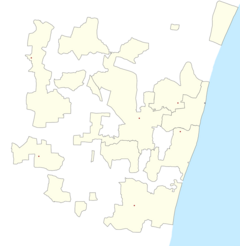Varadaraja Perumal Perundevi Thayar Temple in Puducherry, is dedicated to the Hindu god Vishnu and Hindu goddess Lakshmi. It is located heritage town region of the city. Constructed in the Dravidian style of architecture, the temple is a storehouse of Chola and Pandya architecture.
| Varadharaja Perumal Perundevi Thayar Temple | |
|---|---|
 | |
| Religion | |
| Affiliation | Hinduism |
| District | Puducherry |
| Deity | Varadharaja Perumal (Vishnu) Perundevi Thayar (Lakshmi) |
| Location | |
| Location | Puducherry |
| State | Puducherry |
| Country | India |
Location in Puducherry | |
| Geographic coordinates | 11°56′27″N 79°49′48″E / 11.94083°N 79.83000°E |
| Architecture | |
| Type | Dravidian architecture |
A granite wall surrounds the temple, enclosing all its shrines. The temple has a five-tiered rajagopuram, the temple's gateway tower. The temple is originally believed to have been built by Cholas during the 11th century CE, with later expansion by Pandyas during the 12th century CE.
The temple follows Vaishnavite and Shaktite traditions of worship. Four daily rituals and three yearly festivals are held at the temple, of which the ten-day annual Brahmostavam during the Tamil month of Chithrai (April - May) and five-day Pavitrotsavam during Avani (August - September) and 25-day Rama and Sita's marriage festival during Chithrai being the most prominent. The temple is maintained and administered by the Archaeological Survey of India as a religious monument.
History
editThe temple is originally built by the Cholas from the 11th century CE and subsequently by the Pandyas from the 12th century CE. The regions are destroyed and reconstructed the British Colonial Empire and French Colonial Empire and Indian Subcontinental wars during the 17th century CE. All temples in the area are destroyed and reconstructed during the French and British and Indian Subcontinental wars.[1][2] The temple housed the images of the Vedapurishvarar Tripurasundari Temple during its destruction and reconstruction by the French and Indian Subcontinental Hindu and Christian religious riots during 1748 CE. The images of Rama, Sita, Hanuman, Navanithakrishna, Santhanakrishna and Venugopalan were dug out from Vaithikupam, Puducherry near Muthialpet, Puducherry in 1902 CE and subsequently housed in the temple. It is known that Vasanthamandapa was built by Hindus, Muslims, Christians of the city of Puducherry.[1]
Architecture
editThe five-tiered rajagopuram, the temple's gateway tower, is 110 ft (34 m) tall. The sanctum houses the image of Varadharaja in standing posture 5 ft (1.5 m) is made of granite sporting four arms. Two of his arms hold Panchajanya and Sudharshana Chakra, while the other two have Abayamudra and Kadahasta. The images of Perundevi and Bhumi are located on either of his sides, which also has the festive image. The Ardhamandapa is guarded by two Dvarapalas on either sides. There is a separate shrine of Perundevi, which also houses the festival image. There is a mirror hall in the temple adjacent to the sanctum. There are paintings done in modern days around the walls of the precinct showing the 108 Divya Desams. There are separate shrines for Vaishnava Gurus like Vedanta Desika and Manavala Mamunigal. The temple has 83 springs in the temple tanks and 12 bodies of water. The water in the temple tank is considered to be medicinal and devotees take a dip to cure themselves of common ailments.[1]
Festival and religious importance
editThe temple does not differentiate between Thenkalai and Vadakalai sects of Sri Vaishnavism and follows Pancharatra agamas. In modern times, the temple priests perform the puja (rituals) during festivals and on a daily basis. The temple rituals are performed four times a day: Kalasanthi at 8:00 a.m., Uchikalam at 12:00 p.m., Sayarakshai at 5:00 p.m., and Ardhajamam at 8:00 p.m. Each ritual has three steps: alangaram (decoration), neivethanam (food offering), dipa aradanai (waving of lamps) for both Varadaraja Perumal and Perundevi Thayar. There are weekly, monthly and fortnightly rituals performed in the temple. The major festivals in the temple are the ten day annual Brahmostavam during the Tamil month of Chittirai (April - May) and five day Pavitrotsavam during Avani (August - September) and 25 day Rama and Sita's marriage festival during Chittirai.[1] During the Rama Navami festival, the festive images of Rama, Sita, Lakshmana and Hanuman are taken around the streets of the temple in the temple chariot drawn by thousands of devotees.
Annaprashana, a practise of making the children write their first alphabet in a plate of rice, is a ritual practised in the temple by devotees. The temple is maintained and administered by the Government of Puducherry.[3]
References
edit- ^ a b c d "Sri Varadaraja Perumal temple". Dinamalar. 2014. Retrieved 31 May 2014.
- ^ Pal, Susant (2014). Imbibed In Faith. Partridge Publishing. p. 284. ISBN 9781482812596.
- ^ "Human chain planned in Pondy". The Hindu. Pondicherry. 18 November 2002. Retrieved 17 November 2015.
